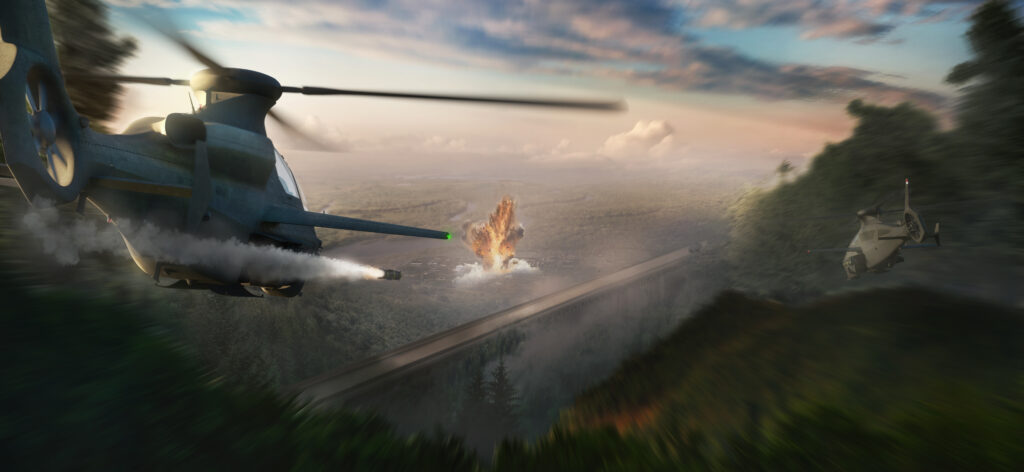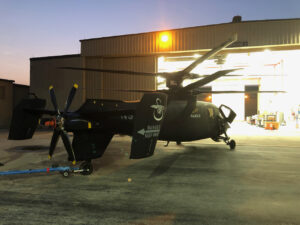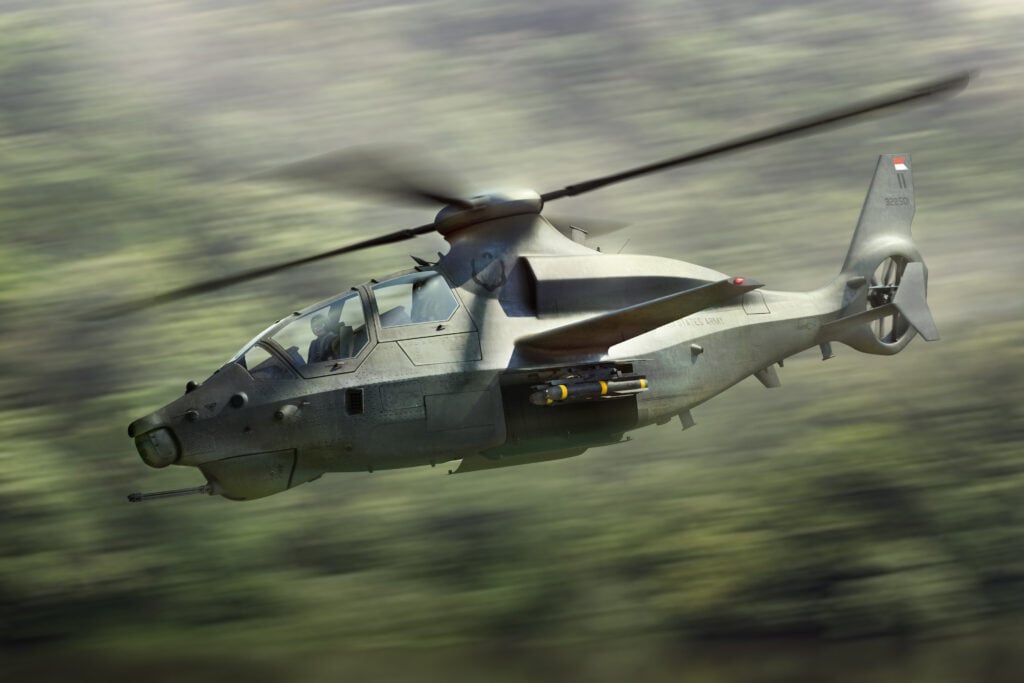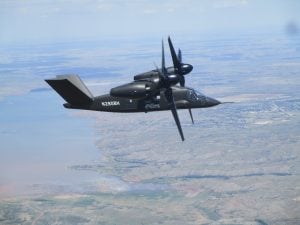
Bell 360 Invictus scout helicopters on an attack run (artist’s rendering). Note the prominent wings to provide extra lift at high speeds and the ducted-fan tail rotor for stability.
CRYSTAL CITY: Unveiled after 18 months of speculation, Bell’s proposal for the Army’s Future Attack Reconnaissance Aircraft is an intriguing paradox. The immodestly named Bell 360 Invictus — Latin for “unconquerable” — is both the most lethal-looking competitor in the running and the underdog trying to win on low operating cost as opposed to high combat speed.
From its front-mounted cannon, to its knife-like little wings, to its deliberately asymmetrical tail rotor, the Bell 360’s sleek and angular lines pack in a lot of innovative engineering. Invisible to the eye but crucial to performance is its all-digital control system, derived from the civilian Bell 525 Relentless. The 525 itself is now undergoing FAA certification as the first production helicopter ever to use fly-by-wire controls instead of mechanical ones. Those electronic controls allow it to exceed an extraordinary 200 knots airspeed (230 mph). Bell hasn’t said whether the 360 will achieve similar speeds, but they’ve done painstaking computer modeling and wind tunnel work to reduce drag.

The Sikorsky S-97 Raider prototype is towed out of its hangar for a flight test. Note the dual main rotors and the pusher propeller in place of a conventional helicopter’s tail rotor.
But at its heart, the Bell 360 is a classic helicopter. It has a big rotor on top for lift and thrust, a little rotor in back for stability, and the aerodynamic limits that come with that configuration, especially in terms of range and speed. Those are the limits that Bell spent decades developing tiltrotors like the V-22 and V-280 to surpass.
Contrast archrival Sikorsky’s S-97 Raider, a helicopter/airplane hybrid featuring ultra-rigid main rotors that can act like wings and a pusher propeller for extra thrust. Like Bell’s tiltrotors, Sikorsky’s compound helicopters are designed specifically to exceed the performance limits of conventional helicopters.
(The other competitors, who haven’t built actual aircraft yet, are Boeing, Karem, and an AVX/L3 team. But Sikorsky and Bell are clearly the front-runners).
So the S-97 is a much more radical change in rotary-wing aircraft design than the Bell 360. Yet at the same time, the S-97 is also a more proven design, because it’s actually flown for years, hitting over 207 knots (238 mph) in test flights. Meanwhile, the closest the Bell 360 has gotten to taking flight is as a scale model in a wind tunnel.
How fast will the Bell 360 go, when it actually flies in late 2022?

Bell 360 Invictus concept
“We will exceed 180 knots with this aircraft,” Bell’s VP for advanced rotorcraft, Keith Flail, told a select group of reporters at an embargoed preview yesterday. 180 knots (207 mph) is the Army’s requirement for cruise speed, the fastest rate the aircraft can sustain over long distances.

Keith Flail
What about the Army’s objective for short bursts of speed, 205 knots (235 mph)? “We will exceed 180 knots with this aircraft,” Flail repeated. “The Army has stated that the speed requirement for this aircraft is 180 knots and we will absolutely exceed 180.”
But 205 knots….
“There is no 205 requirement,” Flail said. “There is no requirement for 205.”
Yes, Flail acknowledged to me after his press briefing, the Army does want the FARA to be able to exceed 180 knots for short periods when needed. But the service hasn’t set a hard-and-fast requirement for that “dash speed.”
“180 [for cruise] is a non-tradable mandatory minimum attribute,” the Army’s FARA program manager, Dan Bailey, confirmed for me in an email. (Emphasis ours). “205 dash is a desired attribute,” he went on, which means the Army will evaluate dash-speed on a “best offering” basis rather than as a pass-fail criterion.
This approach is part of the Army’s new push to be flexible and pragmatic, rather than setting rigid requirements and insisting industry meet them — or try — regardless of the expense or risk of failure. On FARA in particular, the service is giving industry unusual leeway to make tradeoffs between different parameters such as speed, reliability, and cost.
“They’re left a lot of it up to us,” Flail told me.

Bell V-280 Valor tiltrotor in level flight with rotors facing forward. The V-280 is widely considered the leading candidate for the Future Long-Range Assault Aircraft (FLRAA), but its design couldn’t scale down small enough for the FARA scout.
The Army does want higher speed than current helicopters so the FARA scout can slip through cutting-edge anti-aircraft defenses in a future war with Russia or China. But because speed alone doesn’t ensure survival, the Army also wants a small and agile craft, one able to hide behind hills and dodge between buildings. In fact, a maximum rotor diameter of 40 feet was one of the Army’s few non-negotiable requirements. It’s that requirement which ruled out Bell’s trademark tiltrotors, which require two big rotors widely spaced on either side of the fuselage.
What’s more, the Army wants to buy FARA scouts for $30 million apiece, the same price as the AH-64 Apache gunship — a much larger aircraft to be sure but with much less stringent performance requirements. And FARA has to fly day in, day out in harsh conditions, without the lavishly appointed maintenance bases that became standard in Iraq but which would be easy targets for Russian or Chinese long-range missiles.
“At the end of the day,” Flail told me, “you’ve got to maintain this thing in the dirt.”
Since the Bell 360 can’t beat Sikorsky’s S-97 on speed, the company has to emphasize other selling points. The mantra they drummed into reporters at the preview briefing:
“We’re laser focused on affordability,” Flail said more than once. The Bell 360 will be “the most affordable, most sustainable, lowest risk, least complex solution that will meet of all the FARA requirements.”

Jeffrey Schloesser
“if you need a Corvette and can afford a Corvette, do you go buy a Ferrari?” asked Bell’s DC-based executive VP, Jeff Schloesser. “This is not a truck. This is a high-speed agile aircraft at an affordable price that meets all the requirements from the US Army. I wouldn’t want to go make it any more exquisite and harder to maintain.”
At the same time, however, Flail, Schloesser, & co. bristled when I suggested they were offering the low-cost, low-tech contender.
“You can have elegance without being exotic,” Flail said. “It’s really hard to get to simple.”
The Bell 360 has a lot of advanced features that set it apart from traditional rotorcraft, some of them adopted from the civilian Bell 525 but many others are unique:
- The most visible difference is that this helicopter has wings, which provide additional lift. Specifically, the wings give more and more lift as the aircraft goes faster and faster, maxing out at 50 percent. That means the main rotor only has to lift 50 percent of the aircraft at high speeds, allowing it to spend the rest of its power on accelerating the aircraft forward.
- The Bell 360 has an unusual dual powerplant. A GE Improved Turbine Engine provides all the necessary thrust at lower speeds, but at high speeds a Supplemental Power Unit (SPU) kicks in. Again, this is all about making as much power as possible available for acceleration.
- The main rotor’s four blades — scaled-down versions of the blades from the Bell 525 — are mounted in a streamlined hub to minimize drag and are “fully articulated,” allowing them to flex and reposition to bite the air with maximum efficiency at high speeds.
- The aircraft’s landing gear and missile racks are both retractable, allowing them to fold out of the way for high-speed, low-drag flight and only reemerge at lower speeds during landing or an attack run.
- The rear of the aircraft is deliberately asymmetrical, with a single main exhaust vent on the right and the tail rotor set at a noticeable slant. Flail & friends wouldn’t discuss exactly why they chose this design. But a traditional helicopter is always subject to unbalanced forces from the tail rotor, and the Bell 360 seems to embrace the asymmetry as a virtue, perhaps the same way modern fighter aircraft gain much of their agility from being “dynamically unstable.”
- Internally, and as important as any visible feature, the aircraft has all-electronic fly-by-wire controls — a first for a US combat helicopter. (Such controls, incidentally, are essential to keep a dynamically unstable aircraft in the air). It also has a plug-and-play open architecture by Collins Aerospace intended to allow easy replacement and electronics upgrades, not just from Bell and its partners but from any vendor that complies with the Army-led FACE standard.
There’s a tricky balancing act here, not just in the angle of the rotor but in the whole design. On the one hand, Bell wants to be the reliable, low-risk contender, using proven helicopter design principles rather than radical novelties like the Sikorsky S-97. On the other hand, Bell wants to squeeze as much performance as it can out of its essentially conventional configuration, which means packing in a lot of innovation. Yes, much of the new tech was already being refined for the Bell 525, but that’s a new aircraft itself, still working on FAA certification after a fatal crash in 2016. And the Bell 360 itself isn’t yet built.
Bell is positioning its 360 to be a genuinely interesting alternative, the Corvette to Sikorsky’s Ferrari. They have to build it and fly it to prove it works.
In a ‘world first,’ DARPA project demonstrates AI dogfighting in real jet
“The potential for machine learning in aviation, whether military or civil, is enormous,” said Air Force Col. James Valpiani. “And these fundamental questions of how do we do it, how do we do it safely, how do we train them, are the questions that we are trying to get after.”


























